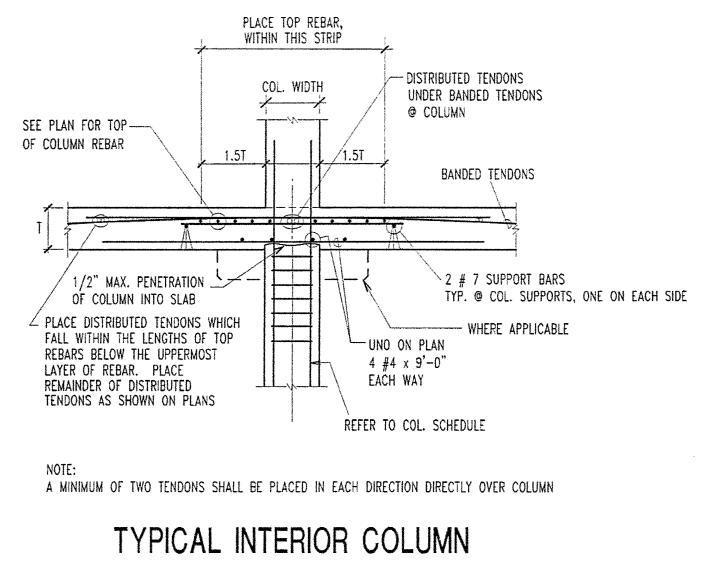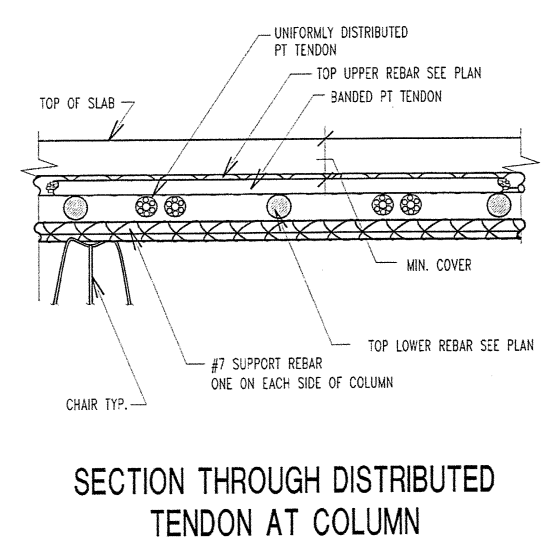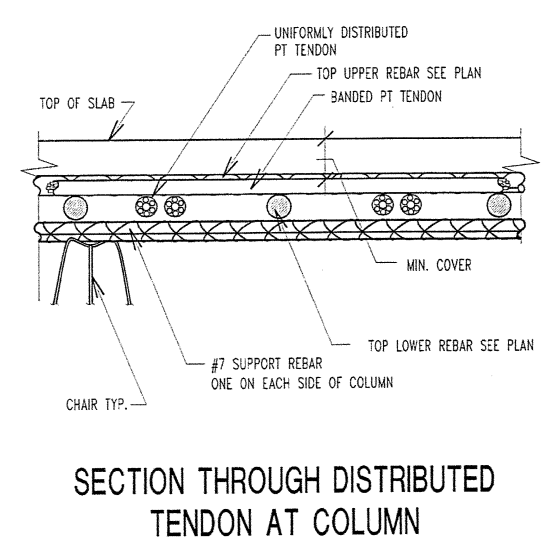Seppe
Structural
- Mar 8, 2016
- 53
Hi all. Question regarding the field interplay of PT tendons and accompanying mild reinforcement.
For two-way unbonded flat plate construction in the vicinity of isolated columns/supports, my understanding has always been that banded tendons maintain maximum drape, and that with the exception of the line of "integrity" distributed tendons aligned directly through the column and right under the banded tendons, all other distributed tendons achieve maximum drape as well. This is conceptually and spatially very clean and easy to achieve.
However, when mild reinforcement is introduced, it seems to me that something's got to give, and in my opinion it really shouldn't be the PT whose positioning is adjusted given the comparative sensitivity of active reinforcement vs. passive reinforcement.
To illustrate, the top rebar running in the banded direction should ideally maintain the same clear cover as that associated with / established by the maximum drape of the banded PT directly over the column. However, for this to happen, the distributed tendons at "max drape" (just on the outer boundary of the column location) would need to tuck under the straightline rebar.
How do you folks account for this aspect of constructability in your design, if at all?
Do you maintain maximum drape of distributed PT in your calculations, and then assume a slight "fall" in the banded rebar by increasing your rebar clear cover dimension by an an extra 0.5" increment?
Do you maintain banded rebar positioning and in turn reduce drape of the affected distributed PT?
Or do you disregard altogether the spatial collision of distributed PT and banded direction rebar, discounting the effect of the rebar dive-down based on the knowledge that negative moment magnitude is significantly reduced at that location?
Perhaps this is a trivial consideration. Nonetheless, I would like to hear your feedback. Thanks, folks.
For two-way unbonded flat plate construction in the vicinity of isolated columns/supports, my understanding has always been that banded tendons maintain maximum drape, and that with the exception of the line of "integrity" distributed tendons aligned directly through the column and right under the banded tendons, all other distributed tendons achieve maximum drape as well. This is conceptually and spatially very clean and easy to achieve.
However, when mild reinforcement is introduced, it seems to me that something's got to give, and in my opinion it really shouldn't be the PT whose positioning is adjusted given the comparative sensitivity of active reinforcement vs. passive reinforcement.
To illustrate, the top rebar running in the banded direction should ideally maintain the same clear cover as that associated with / established by the maximum drape of the banded PT directly over the column. However, for this to happen, the distributed tendons at "max drape" (just on the outer boundary of the column location) would need to tuck under the straightline rebar.
How do you folks account for this aspect of constructability in your design, if at all?
Do you maintain maximum drape of distributed PT in your calculations, and then assume a slight "fall" in the banded rebar by increasing your rebar clear cover dimension by an an extra 0.5" increment?
Do you maintain banded rebar positioning and in turn reduce drape of the affected distributed PT?
Or do you disregard altogether the spatial collision of distributed PT and banded direction rebar, discounting the effect of the rebar dive-down based on the knowledge that negative moment magnitude is significantly reduced at that location?
Perhaps this is a trivial consideration. Nonetheless, I would like to hear your feedback. Thanks, folks.




![[bigsmile] [bigsmile] [bigsmile]](/data/assets/smilies/bigsmile.gif)